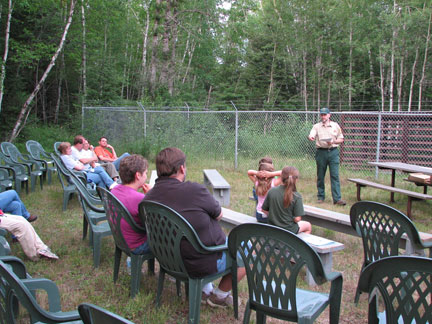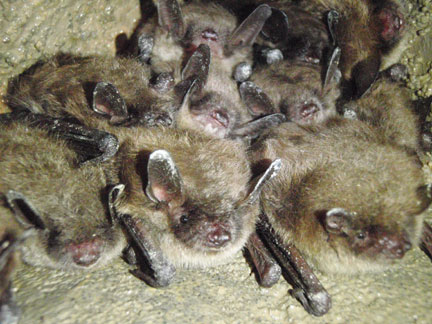Fewer Bats Means More Bugs: Why Bats Are More Friend Than Foe
By Deborah Locke, DNR Information Officer
White nose syndrome (WNS) has already killed thousands of Minnesota bats, a fact lost on most people. Why should they care? After all, folklore and popular culture suggests that bats are scary.
Minnesota DNR researchers, scientists, naturalists and park managers have a different view on the small creatures. Some staff members really like bats and teach about them; others are doing their best to protect them from the disease.
State parks are home to two large bat colonies that hibernate during the winter months at Mystery Cave at Forestville/Mystery Cave State Park, and at the mine at Lake Vermilion-Sudan Underground State Parks. Ninety percent of the bat population at the Sudan mine has died, and 70 percent of the bat population at Mystery Cave has died, said Gerda Nordquist, a DNR specialist whose team monitors the state bat population. Overall, between five and six million bats have died from WNS, she said.
Since 2009, the DNR has worked with University of Minnesota scientists, other state, federal and tribal agencies and local group to fight the disease now reported in 10 Minnesota counties. There are eight bat species in Minnesota, and four of those species are vulnerable to WNS.
The declined population impacts humans in that fewer bats means more flying bugs. Bats prey on flying insects like mosquitoes, moths and biting flies. A pregnant bat will eat enough insects to equal its weight, Nordquist said. More biting insects creates problems for humans as well as for agricultural crops that become susceptible to insect infestations without bats to keep the bugs in line.
Bob Storlie, Mystery Cave manager, has noticed the sharp decline in the winter bat population. “Our bats have no resistance since with a fungus, they can’t develop an immunity, just resistance,” he said. The fungus, which originated in Europe, flourishes in cool environments. The fungus attaches to a bat, which awakes from hibernation and becomes active. That activity causes the bat to burn too much fat and they starve. WNS also compromises a bat’s immune system.
Meanwhile, as WNS continues its onslaught on bats, so does popular culture and myth. “Folklore has bats sucking blood,” Storlie said. North American bats don’t suck blood, nor do they fly into people’s hair. Nor are they blind. In fact, bats have a lot going for them.
“How cool is it that they hang upside down, they are the only mammal that flies, and they use echolocation to find food and fly around without hitting obstacles,” said James Pointer, mine interpretive supervisor at Sudan Underground Mine. He teaches “Batty About Bats” programs designed to show the public why bats are important and non-threatening. Movies and stories depict bats as scary. Plus they are active at night, which means people never see them really well.
“When people learn more about bats and see the great impact they have on our environment and well-being, it eases their fears,” he said. During his presentation to mine visitors, Pointer explains that bats have specialized diets depending on their species. Little Brown Bats eat a variety of insects, with mosquitoes making up only 20 percent of their diet, and Big Brown bats focus on beetles. He added that if you buy a bat toy or decoration, they’re usually black. However, most bats are brown in color. When Pointer’s children were young, he read “Stellaluna” to them, a story about a bat and birds and how they are both similar and different.
To ensure that future generations of children have the chance to read and learn about bats, the DNR continues to monitor the health of bats. Winter and summer monitoring takes place, and the DNR continues to assist with research projects designed to track WNS growth as well as find a cure. During one data-collective visit to Mystery Cave, Bob Storlie watched as Gerda Nordquist used a tip to swab a bat. He gets questions from cave visitors about bats, he said, some who are curious and others who show fear.
“Education is the best thing,” he said. “Some may have a fear of bats, but once they understand the value of the creatures, they start thinking more positively.”
The Minnesota DNR needs your help to watch for unusual winter bat behavior. We also want to know about any summer bat colonies. You can send bat information to the Online Bat Observation Report: www.mndnr.gov/reportbats, or contact the MNDNR Minnesota Biological Survey bat specialist: Gerda Nordquist at 651-259-5124, gerda.nordquist@state.mn.us


























